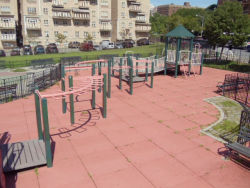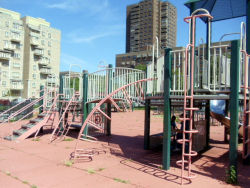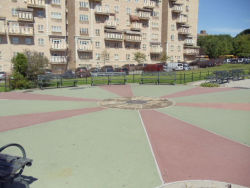Jacob's Ladder Playground
Jacob’s Ladder Playground
Jacob’s Ladder is a plant that can be found in temperate zones throughout the world. It refers to any of the 25 species that are classified in the Polemonium genus. Many of these species are cultivated in gardens, and can be recognized by their clusters of drooping blue, violet, or white flowers that bloom in late spring. The flowers are shaped like a funnel and typically have five petals. The leaves of the plants are normally oriented in a pattern that resembles a ladder, and thus the popular name. When crunched, certain species’ leaves emit a pungent smell, which has given rise to the alternative popular name skunkweed. Several species are also known for their ability to thrive in wild habitats ranging from shady forests to sunny meadows. Jacob’s Ladder can even be found growing in the rocky soil on mountaintops and along roadsides.
Native Americans used a preparation of Jacob’s Ladder to clean their hair and treat certain skin conditions. Europeans also cultivated various species because of their supposed medicinal purposes. The herbalist Culpepper (1616-1654) claimed that one species could effectively treat harmful fevers and “pestilential distempers.” It was also useful in the treatment of trembling, heart palpitations, headaches, and nervous conditions. In fact, the genus Polemonium takes its name from a medicinal plant associated with the Greek philosopher Polemos of Cappadocia.
The plant’s popular name is derived from a biblical story in the Old Testament Book of Genesis (Chapter 28: 12-22). Isaac instructed his son Jacob to leave Bersheva and go to Charan to find a wife. On his way, he stopped to rest for the night and had a vivid dream. In it, he saw a ladder in the sky upon which hosts of angels were witnessed ascending and descending between earth and heaven. Standing above Jacob, God promised to bless Jacob and his children, and to give them the land on which Jacob had been sleeping. When Jacob awoke, he took the stone he had used as a pillow and set it upright as a pillar, which he then anointed with oil. He named the place Bethel, and resolved that if God were to protect him, then he would honor God and make the pillar the House of God. According to many, the spot where Jacob slept and received his revelation was the Temple Mount in Jerusalem. The ladder symbolizes the connection at that place between this world and the higher world—and the promise made between God and Jacob.
Williamsburg’s 1.5-mile coastline along the East River attracted industrial development during the 19th and early 20th centuries. The departure of many manufacturing companies and the construction of the Brooklyn-Queens Expressway dramatically changed the neighborhood after World War II. Blocks of old factory and tenement buildings were demolished to make room for public housing.
The federally-funded Williamsburg Urban Renewal Area Program was inaugurated in 1968, in part to create new public open spaces for the community. In 1986 Parks acquired two parcels in the target area and developed plans for two different recreation facilities, one for active play and one for passive enjoyment. The first phase of the proposal, construction of the Roberto Clemente Ballfield, located on Division Avenue between Wythe and Kent Avenues got underway in 1995 and was complete by 1998. The second phase of the proposal, construction of the Jacob’s Ladder Playground, located on Clymer Street between Wythe and Kent Avenues, got underway in 1996 and was complete by 1999.
After old buildings were demolished and the land was cleared for building purposes, construction of the playground began. Mayor Rudolph W. Giuliani provided $1,088,000 for the playground that includes a large sitting area and a play area separated by a wrought iron fence. The sitting area, replete with World’s Fair benches and mostly American linden (Tilia americana) trees, overlooks the East River and the Manhattan skyline. A large yellow compass stone with red and green pavement radiating from the circle leads to a winding path descending to an entrance on Kent Avenue. The play area, covered in red safety surfacing, contains modular red, white, and green play equipment and tot swings. The entire playground is surrounded by wrought iron fencing with fish animal art on the Kent Avenue gates and seahorse and crab animal art on the Wythe Avenue gates. Bordering the playground is an expanse of grass planted with various shrubs and flowers near the paths and sitting areas.
Check out your park's Vital Signs
Clean & Safe
Green & Resilient
Empowered & Engaged Users
Share your feedback or learn more about how this park is part of a
Vital Park System



